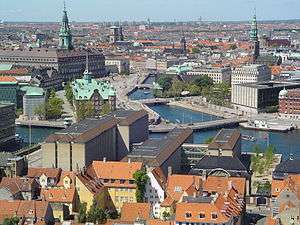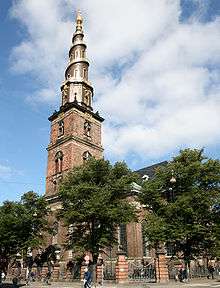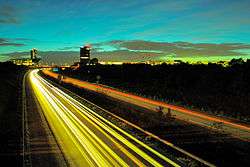Architecture in Copenhagen

The architecture of Copenhagen in Denmark is characterised by a wide variety of styles, progressing through Christian IV's early 17th century landmarks and the elegant 17th century mansions and palaces of Frederiksstaden, to the late 19th century residential boroughs and cultural institutions to the modernistic contribution of the 20th century such as Arne Jacobsen's National Bank and SAS Royal Hotel. Since 2000 Copenhagen has seen a boom in modern architecture with notable contributions both by leading international architects and a wave of new successful Danish architects.
Medieval times
The oldest preserved building in Copenhagen's inner city is considered to be the Church of St. Petri. Its tower, the central nave and the choir date back to the 16th century. The most important medieval building in the Copenhagen area is Roskilde Cathedral from 1170 located in the city of Roskilde west of Copenhagen that used to be the country's capital before Copenhagen.
Renaissance
Over the centuries Copenhagen grew in importance and a number of important landmarks of present-day Copenhagen date back to the late 16th and early 17th centuries. This can also be attributed to the personal effort of Christian IV which is popularly known as the builder king in Denmark because of his legacy of and involvement in large building projects.[1] Rosenborg Castle and his stock exchange in central Copenhagen as well as Frederiksborg Palace in Hillerød are both build in Dutch Renaissance. Christian IV also founded the neighbourhoods of Christianshavn and Nyboder as well as such important green spaces as King's Garden and Kastellet.
Baroque

Baroque buildings in Copenhagen include the Round Tower and the Church of Our Saviour as well as Fredensborg Palace.
Rococo
Frederiksstaden was constructed during the reign of Frederick V in the second half of the 18th century and is considered to be one of the most important rococo complexes in Europe.[2] It was developed to commemorated the 300 years jubilee of the House of Oldenburg taking the throne in Denmark. Leading the project was A. G. Moltke, with Nicolai Eigtved as the main architect. Frederiksstaden has Amalienborg Palace and Marble Church at its centre and together they create an axis that was extended with the creation of the new Copenhagen Opera House in 2005 on the other side of the harbour basin . The district is characterized by straight broad streets in a straight-angled street layout. The streets are lined by burgois houses, mansions and palaces. Another important building in the district is the royal Frederiks Hospital was Denmark's first hospital in the present-day meaning of the word. It now houses the Danish Museum of Art & Design.
21st century

Recent years have seen a boom in modern architecture in Copenhagen[3] both for Danish architecture and for works by international architects. For a few hundred years, virtually no foreign architects had worked in Copenhagen, but since the turn of the millennium the city and its immediate surroundings have seen buildings and projects designed by top international architects. At the same time, a number of Danish architects have achieved success in Copenhagen and abroad.
Buildings in Copenhagen have won RIBA European Awards four years in a row ("Sampension" in 2005,[4] "Kilen" in 2006,[5] "Tietgenkollegiet" in 2007 and the Royal Playhouse in 2008.[6]) The last three are all by Lundgaard & Tranberg Architects.[7] At the 2008 World Architecture Festival in Barcelona, Bjarke Ingels Group won an award for the World's Best Residential Building 2008 for a house in Ørestad.[8] In 2008 British design magazine Monocle named Copenhagen the World's best design city 2008.[9]
See also
References
- ↑ "Christianshavn - a canal-town in the heart of the city of Copenhagen". The Canal Boat Club. Retrieved 2009-01-05.
- ↑ Frederiksstaden Arksite
- ↑ "B1 Kopenhagen entdecken" (in German). Baumeister – Zeitschrift für Architektur. 2009. Retrieved 2016-02-12.
- ↑ "RIBA European Awards 2005". RIBA.
- ↑ "RIBA European Awards 2006". RIBA. Archived from the original on 26 June 2009.
- ↑ "RIBA European Awards 2009". RIBA. Archived from the original on 11 October 2008.
- ↑ "Lundgaard & Tranberg Architects". Ltarkitekter.dk. Retrieved 9 March 2013.
- ↑ "World's Best Residential Building 2008". World Architecture Festival. Archived from the original on 25 December 2008.
- ↑ Dugan, Emily (9 June 2008). "World's best design city 2008". The Independent. UK.